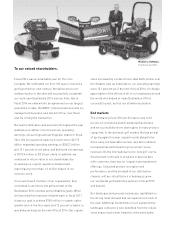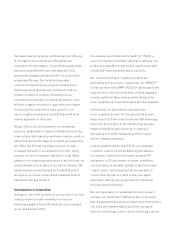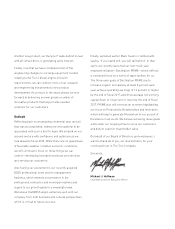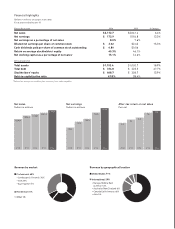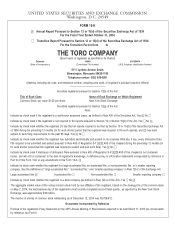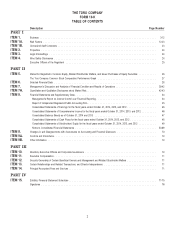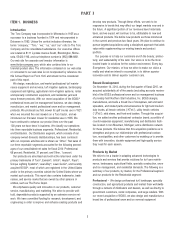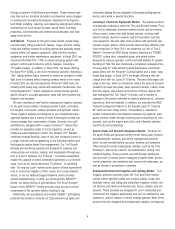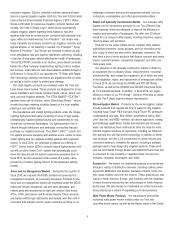Toro 2014 Annual Report Download - page 13
Download and view the complete annual report
Please find page 13 of the 2014 Toro annual report below. You can navigate through the pages in the report by either clicking on the pages listed below, or by using the keyword search tool below to find specific information within the annual report.process. We strive to make improvements to our new product Our production levels and inventory management goals are
development system as part of our continuing focus on Lean meth- based on estimates of retail demand for our products, taking into
ods to shorten development time, reduce costs, and improve account production capacity, timing of shipments, and field inven-
quality. tory levels. Our production system utilizes Kanban, supplier pull,
Our engineering expenses are primarily incurred in connection and build-to-order methodologies in our manufacturing facilities, as
with the development of new products that may have additional appropriate, for the business units they support in order to better
applications or represent extensions of existing product lines, align the production of our products to meet customer demand. We
improvements to existing products, and cost reduction efforts. Our believe this has resulted in improved service levels for our partici-
expenditures for engineering and research were $69.7 million pating suppliers, distributors, and dealers.
(3.2 percent of net sales) in fiscal 2014, $64.6 million (3.2 percent We periodically shut down production at our manufacturing facili-
of net sales) in fiscal 2013, and $60.1 million (3.1 percent of net ties in order to allow for maintenance, rearrangement, capital
sales) in fiscal 2012. equipment installation, and as needed, to adjust for market
demand. Capital expenditures for fiscal 2015 are planned to be
Manufacturing and Production approximately $75 million as we expect to continue to invest in
We have strategically identified specific core manufacturing compe- new product tooling, new technology in production processes and
tencies for vertical integration, such as injection molding, extrusion, equipment, replacement production equipment, as well as renova-
welding, painting, machining, and aluminum die casting, and have tions of our original corporate facility located in Bloomington, Min-
chosen outside vendors to provide other services. We design com- nesota to accommodate expansion needs of our product develop-
ponent parts in cooperation with our vendors, contract with them ment and test capacities.
for the development of tooling, and then enter into agreements
with these vendors to purchase component parts manufactured Raw Materials
using the tooling. In addition, our vendors regularly test new tech- We purchase raw materials such as steel, aluminum, petroleum
nologies to be applied in the design and production of component and natural gas-based resins, linerboard, and other commodities,
parts. Manufacturing operations include robotic and computer-auto- and components, such as engines, transmissions, transaxles,
mated equipment intended to speed production, reduce costs, and hydraulics, and electric motors, for use in our products. In addition,
improve the quality, fit, and finish of our products. Operations are we are a purchaser of components and parts containing various
also designed to be flexible enough to accommodate product commodities, including steel, aluminum, copper, lead, rubber, and
design changes that are necessary to respond to market condi- others that are integrated into our end products. During fiscal
tions and changing customer requirements. 2014, we experienced slightly higher average commodity prices
In order to utilize our manufacturing facilities and technology compared to the average prices paid for commodities in fiscal
more effectively, we pursue continuous improvements in our manu- 2013, which hindered our gross margin growth rate in fiscal 2014
facturing processes with the use of Lean methods that are as compared to fiscal 2013. We anticipate commodity prices in
intended to streamline work and eliminate waste. We spend con- fiscal 2015 to be slightly higher compared to average prices paid
siderable effort to reduce manufacturing costs through Lean meth- for commodities during fiscal 2014. Historically, we have mitigated,
ods and process improvement, product and platform design, appli- and we currently expect to continue to mitigate, commodity cost
cation of advanced technologies, enhanced environmental increases, in part, by collaborating with suppliers, reviewing alter-
management systems, safety improvements, and improved supply- native sourcing options, substituting materials, engaging in internal
chain management. We also have some agreements with other cost reduction efforts, and increasing prices on some of our prod-
third party manufacturers to manufacture products on our behalf. ucts, all as appropriate.
Our professional products are manufactured throughout the year, Most of the raw materials and components used in our products
including the snow and ice management products from our recent are also affected by commodity cost pressures, are commercially
acquisition of the BOSS business, as previously discussed. Our available from a number of sources, and are in adequate supply.
residential lawn and garden products are also generally manufac- However, certain of our components are sourced from single sup-
tured throughout the year. However, our residential snow thrower pliers. In fiscal 2014, we experienced no significant work stop-
products are manufactured in the summer and fall months but may pages because of shortages of raw materials or commodities. The
be extended into the winter months, depending upon demand. Our highest raw material and component costs are generally for steel,
products are tested in conditions and locations similar to those in engines, hydraulic components, transmissions, plastic resin, and
which they are used. We use computer-aided design and manufac- electric motors, all of which we purchase from several suppliers
turing systems to shorten the time between initial concept and final around the world.
production. DFM/A principles are used throughout the product
development process to optimize product quality and cost.
7


